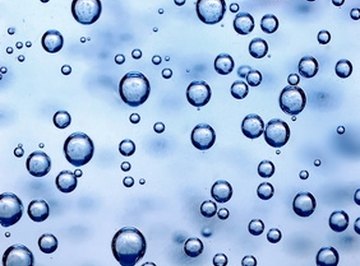
Many chemical reactions result in the generation of a gaseous product. Although most gas-producing reactions carried out, for example, in introductory-level chemistry labs generate hydrogen, oxygen or carbon dioxide, a few also produce nitrogen. The reaction between sodium nitrite, NaNO2, and sulfamic acid, HSO3NH2, for example, produces sodium hydrogen sulfate, or NaHSO4, water, or H2O and nitrogen gas, N2. The experimenter can even carry out the reaction inside a syringe to capture the nitrogen, although doing so requires some specialized equipment.
- 3.5 grams sodium nitrite
- Balance capable of measuring to 0.1 grams
- Small cup or flask
- Water
- 100-milliliter graduated cylinder
- Empty 16- or 20-ounce plastic bottle
- 4 grams sulfamic acid
- Balloon
- Baking soda (sodium bicarbonate)
The reaction described above should generate about 1.6 liters of nitrogen gas. The proportions of reagents, however, are directly scalable, i.e., halving all masses and volumes will reduce the nitrogen volume by half.
Sodium nitrite is toxic, and sulfamic acid is both toxic and corrosive and forms strong acids in water. The use of safety glasses and rubber gloves is strongly recommended. Always work in a well-ventilated area and avoid breathing sulfamic acid dust. Do not mix sulfamic acid and sodium nitrite in the solid state. In the absence of water, they will form noxious fumes instead of nitrogen. Do not confuse sodium nitrite, NaNO2, with sodium nitrate, NaNO3. Sodium nitrate will not produce nitrogen when combined with sulfamic acid.
Weight out about 3.5 grams of solid sodium nitrite on a balance and transfer it to a small cup or flask. Add about 50 mL of water to the flask or cup and swirl or stir the contents until the sodium nitrite completely dissolves. Transfer the solution to a 100-mL graduated cylinder and then add water to a final volume of 100 mL. Transfer the solution to an empty 16- or 20-ounce plastic bottle, which will serve as the reaction vessel.
Weight out about 4.0 grams of solid sulfamic acid and set it aside.
Prepare to start the reaction by having a balloon ready to place over the opening of the bottle as soon as you add the sulfamic acid. Then, in a well-ventilated area, position the bottle upright, quickly add the sulfamic acid to the bottle and immediately snap a balloon over the bottle’s opening. The generation of nitrogen gas should begin immediately.
Monitor the reaction closely to ensure that the balloon does not overinflate and pop off the bottle. Do not, however, at any time point the bottle toward yourself or another person. When the balloon stops inflating, or if the balloon appear to be fully inflated, pinch the balloon at the neck and remove it from the bottle. The balloon contains nitrogen gas with a trace of air.
Neutralize the sulfamic acid and sodium nitrite solution by adding baking soda (sodium bicarbonate) to the bottle until it no longer evolves gas, then dispose of the solution down a drain. Rinse all glassware and apparatus with a sodium bicarbonate solution and then rinse them thoroughly or, in the case of the plastic bottle, throw them away.
Things You'll Need
Tips
Warnings
References
Photo Credits
Clean water and water bubbles in blue image by Suto Norbert from Fotolia.com
